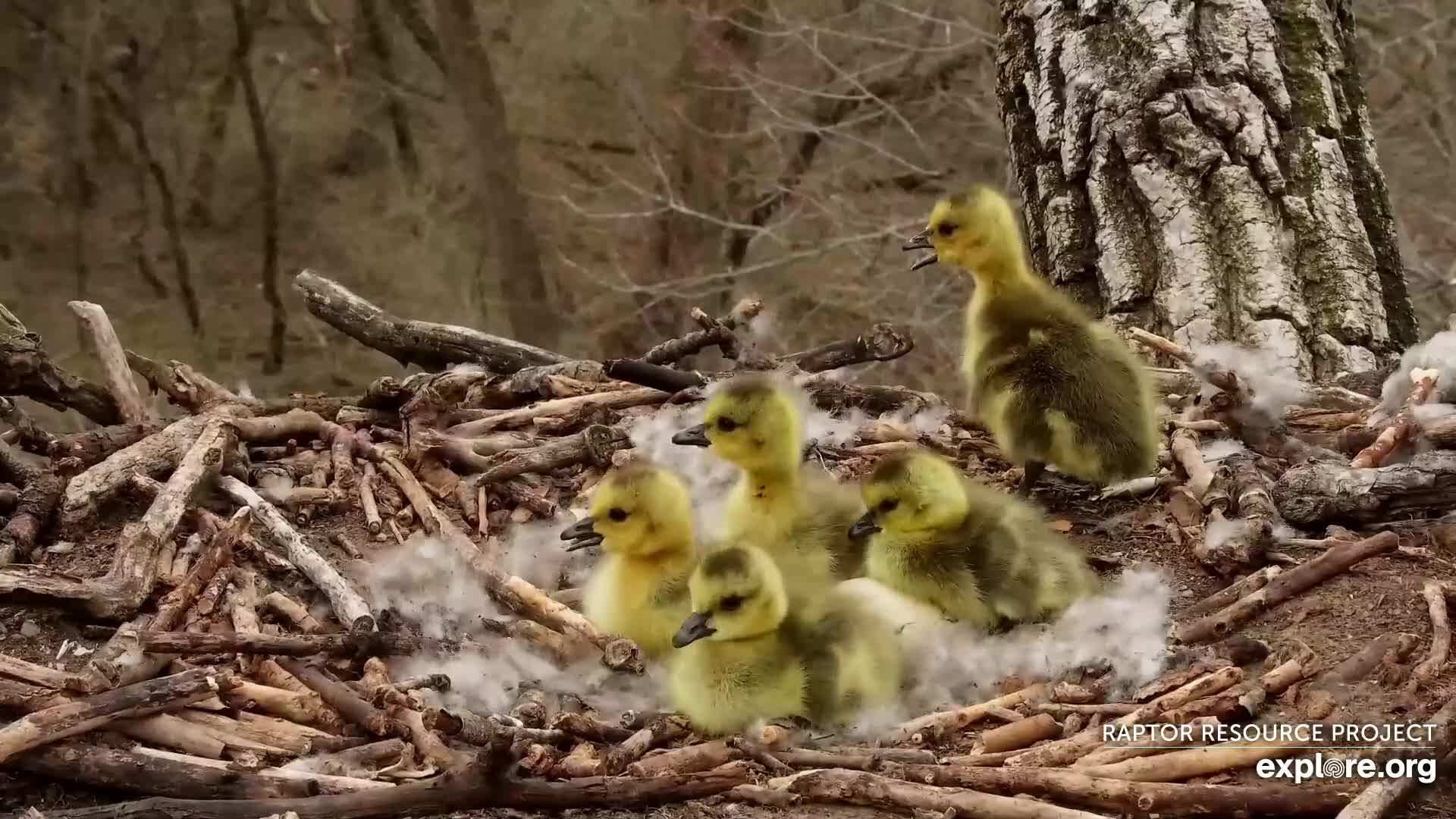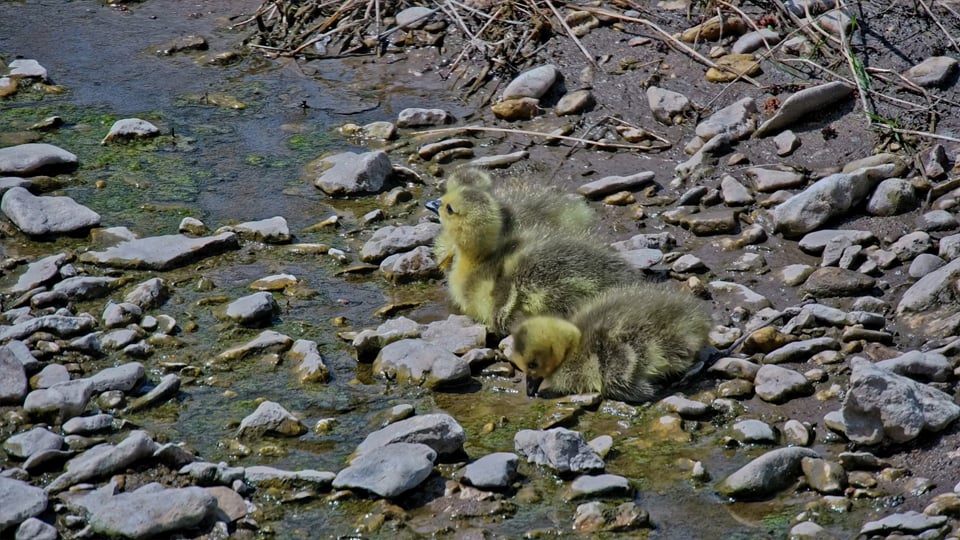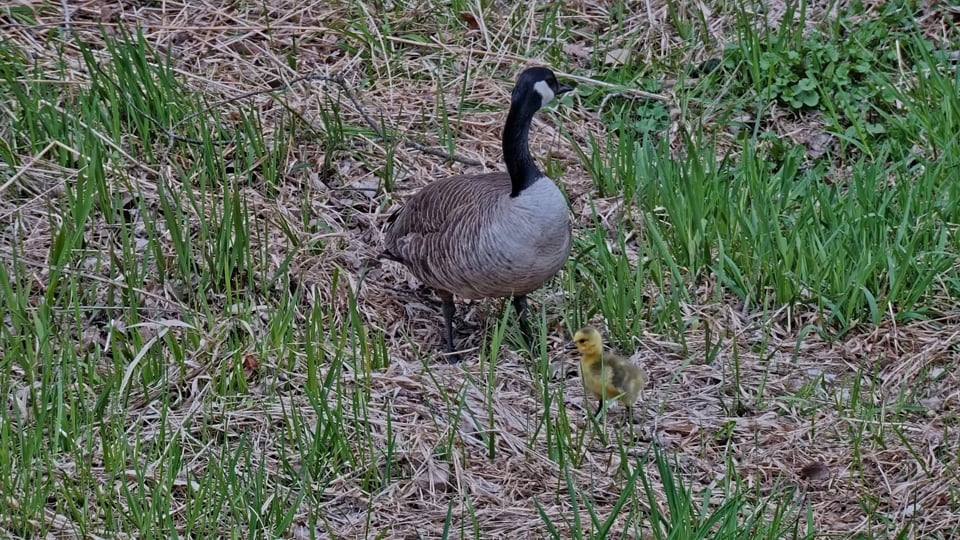The goslings in N1 are hatching and we’re getting a lot of questions about the gosling Leap of Faith, which should happen tomorrow or Monday. Will the goslings jump? How will they survive? Are they really ready to leave the nest? Read on for the answers to your questions!
Will the goslings really jump?

They will! Watch for The Leap of Faith to happen roughly 24 to 48 hours after hatch. Mother Goose will leave the nest and both parents will start vocalizing. The already-busy goslings will become even more excited and eventually leap or tumble towards the sound of their parents’ voices.
If you watched last year, you’ll remember how rambunctious they got before leaping!
How will they survive?
When things fall, the momentum they gain falling has to go somewhere when the fall stops. As climbers say: “It isn’t the fall that kills you, it’s the stop.” Whether or not the object breaks depends on the physical characteristics of the object (mass, brittleness, springiness) and the ability of the struck surface to absorb energy. If I drop a plate on a trampoline, the plate bounces. If my cat knocks the same plate on to a tile floor, the plate shatters. And if I drop a ball on either one, the ball bounces!
How about the goslings? Momentum = mass x velocity. Goslings weigh just three ounces at hatch: about as much as two dental floss picks, three pieces of sliced bread, three AA batteries, or anything else listed here. Mass and weight aren’t really the same, but the goslings don’t have much of either one. And they flap their tiny little wings as they fall, which reduces their velocity. They don’t have nearly as much momentum to dissipate as, say, a 160-pound human falling out of the same tree.
Are the goslings likely to shatter on impact?

Adult birds, like adult humans, have rigid bones that shatter and break when their force threshold is exceeded. But young waterfowl have a high percentage of chondroid bone, a springy skeletal tissue intermediate between cartilage and bone. Sadly, our 160-pound human is lying at the bottom of the tree with a lot of broken bones and probably some punctured internal organs. But the gosling’s light weight and springy skeleton let it bounce, which dissipates the energy of the landing without breaking the gosling’s bones. Human zero, gosling one!
Let’s talk about the landing surface!

If a gosling, a 160-pound human, or my plate falls 70 feet and hits a hard surface that can’t absorb energy, the force of the fall – its momentum – will be dissipated through their bodies. The plate will shatter, the human’s rigid bones will break, and the gosling’s low momentum and springy bones might not be enough to save it. But if any of them hit a surface that can absorb energy, at least some of their momentum will be dissipated elsewhere: think of muddy river banks, soft grass, brush, and so on. Those things aren’t going to be enough to save our 160-pound human, who has rigid bones and a lot of momentum. But the light, springy gosling will be fine.
Why are the parents nesting in a tree? Are they stupid?

Some of you are questioning the intellectual capacity of Mother and Father Goose. Don’t they know that geese nest on the ground? This question gets right to the heart of watching a wild nest. It can be incredibly stressful to watch birds do things that seem bad for them, but they understand their lives better than we do.
It’s important to remember that we haven’t seen geese nesting in abandoned eagle nests because bald eagles were largely gone. The Bald Eagle disappeared from Iowa in 1905 and didn’t return to nest until 1977. For 62 years – I’m giving the last nests ten years to dwindle – Canada geese in Iowa didn’t have the choice to nest on high. I think, based on documentation from the early to mid-1900’s, that we are seeing the resumption of an old, instinctual behavior. While the leap isn’t without risks, adults, eggs, and goslings are free from ground-based predators like dogs, cats, skunks, coyotes, foxes, humans, and some species of snakes. Tree nests might also be easier to protect from geese who want to dump their eggs in someone else’s nest.
If you remember Wild Kingdom, you might enjoy this video! Where Geese Nest in Trees: https://youtu.be/wHyuYvvNMe4.
Are the goslings really ready to leave the nest? It takes eagles a long time to fledge!
There are a lot of ways to group birds. Depending on what we want to do, we can apply traditional taxonomy (class, order, family, species), habitat (waterfowl, shorebirds, upland birds, marine birds, and so on), status (critically endangered, endangered, vulnerable, near threatened, species of least concern), or self-sufficiency following hatch. Precocial birds like Canada Geese can care for themselves shortly after hatch. They can thermoregulate, run, swim, and find their own food, although their parents protect them and lead them to feeding spots. But altricial birds like Bald Eagles are relatively immobile, can’t thermoregulate, and need to be fed. Nestling eaglets and peregrines don’t leave the nest or procure their own food until they fledge. Goslings leave the nest within 24-48 hours of hatching and do not return to it. To learn more about precocial versus altricial, follow this link! https://www.raptorresource.org/2023/04/21/canada-geese-precocial-versus-altricial-2/.
Resources
 The Raptor Resource Project
The Raptor Resource Project The Raptor Resource Project
The Raptor Resource Project